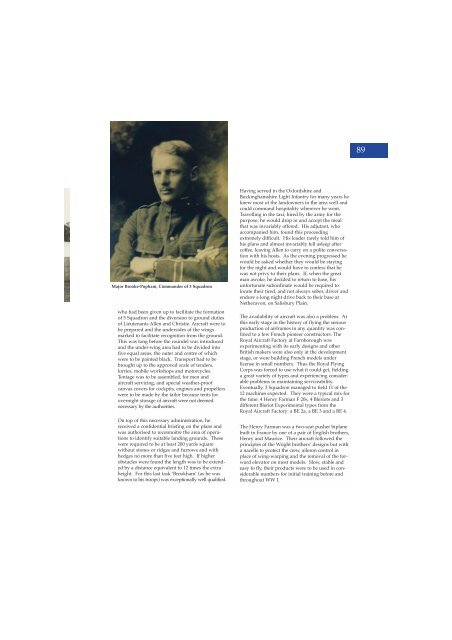Volume 6 No 4 - Royal Air Force Centre for Air Power Studies
Volume 6 No 4 - Royal Air Force Centre for Air Power Studies
Volume 6 No 4 - Royal Air Force Centre for Air Power Studies
Create successful ePaper yourself
Turn your PDF publications into a flip-book with our unique Google optimized e-Paper software.
89<br />
Major Brooke-Popham, Commander of 3 Squadron<br />
who had been given up to facilitate the <strong>for</strong>mation<br />
of 5 Squadron and the diversion to ground duties<br />
of Lieutenants Allen and Christie. <strong>Air</strong>craft were to<br />
be prepared and the undersides of the wings<br />
marked to facilitate recognition from the ground.<br />
This was long be<strong>for</strong>e the roundel was introduced<br />
and the under-wing area had to be divided into<br />
five equal areas, the outer and centre of which<br />
were to be painted black. Transport had to be<br />
brought up to the approved scale of tenders,<br />
lorries, mobile workshops and motorcycles.<br />
Tentage was to be assembled, <strong>for</strong> men and<br />
aircraft servicing, and special weather-proof<br />
canvas covers <strong>for</strong> cockpits, engines and propellers<br />
were to be made by the tailor because tents <strong>for</strong><br />
overnight storage of aircraft were not deemed<br />
necessary by the authorities.<br />
On top of this necessary administration, he<br />
received a confidential briefing on the plans and<br />
was authorised to reconnoitre the area of operations<br />
to identify suitable landing grounds. These<br />
were required to be at least 200 yards square<br />
without stones or ridges and furrows and with<br />
hedges no more than five feet high. If higher<br />
obstacles were found the length was to be extended<br />
by a distance equivalent to 12 times the extra<br />
height. For this last task ‘Brookham’ (as he was<br />
known to his troops) was exceptionally well qualified.<br />
Having served in the Ox<strong>for</strong>dshire and<br />
Buckinghamshire Light Infantry <strong>for</strong> many years he<br />
knew most of the landowners in the area well and<br />
could command hospitality wherever he went.<br />
Travelling in the taxi, hired by the army <strong>for</strong> the<br />
purpose, he would drop in and accept the meal<br />
that was invariably offered. His adjutant, who<br />
accompanied him, found this proceeding<br />
extremely difficult. His leader rarely told him of<br />
his plans and almost invariably fell asleep after<br />
coffee, leaving Allen to carry on a polite conversation<br />
with his hosts. As the evening progressed he<br />
would be asked whether they would be staying<br />
<strong>for</strong> the night and would have to confess that he<br />
was not privy to their plans. If, when the great<br />
man awoke, he decided to return to base, his<br />
un<strong>for</strong>tunate subordinate would be required to<br />
locate their tired, and not always sober, driver and<br />
endure a long night drive back to their base at<br />
Netheravon, on Salisbury Plain.<br />
The availability of aircraft was also a problem. At<br />
this early stage in the history of flying the serious<br />
production of airframes in any quantity was confined<br />
to a few French pioneer constructors. The<br />
<strong>Royal</strong> <strong>Air</strong>craft Factory at Farnborough was<br />
experimenting with its early designs and other<br />
British makers were also only at the development<br />
stage, or were building French models under<br />
license in small numbers. Thus the <strong>Royal</strong> Flying<br />
Corps was <strong>for</strong>ced to use what it could get, fielding<br />
a great variety of types and experiencing considerable<br />
problems in maintaining serviceability.<br />
Eventually, 3 Squadron managed to field 11 of the<br />
12 machines expected. They were a typical mix <strong>for</strong><br />
the time: 4 Henry Farman F 20s, 4 Bleriots and 3<br />
different Bleriot Experimental types from the<br />
<strong>Royal</strong> <strong>Air</strong>craft Factory: a BE 2a, a BE 3 and a BE 4.<br />
The Henry Farman was a two-seat pusher biplane<br />
built in France by one of a pair of English brothers,<br />
Henry and Maurice. Their aircraft followed the<br />
principles of the Wright brothers’ designs but with<br />
a nacelle to protect the crew, aileron control in<br />
place of wing-warping and the removal of the <strong>for</strong>ward<br />
elevator on most models. Slow, stable and<br />
easy to fly, their products were to be used in considerable<br />
numbers <strong>for</strong> initial training be<strong>for</strong>e and<br />
throughout WW I.
















